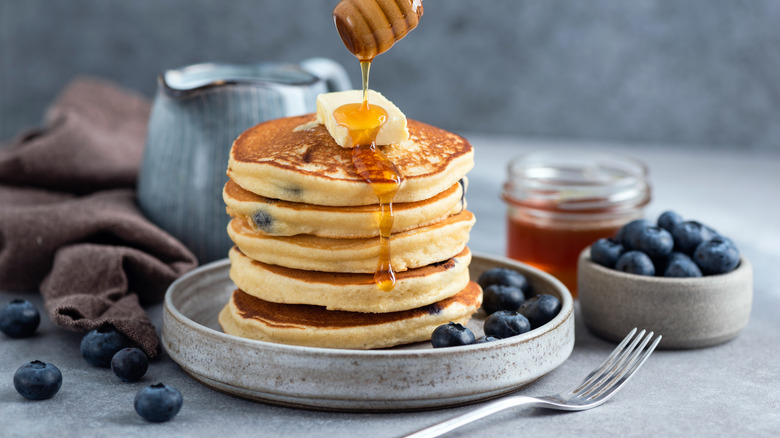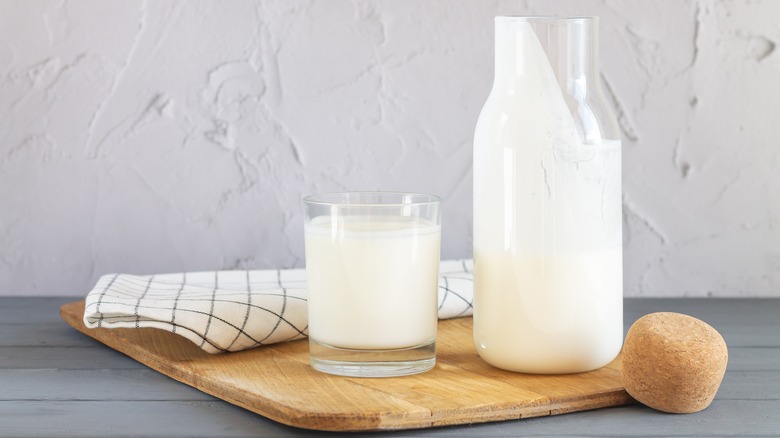The Buttermilk Substitute That Makes Pancakes Even Tastier
Pancakes are a global sensation, with different cultures boasting their own rendition, from super thin French crepes and Italian crespelle to yeasted Russian blinis and baked Finnish pannakakku. For most Americans, however, when we think of pancakes, what comes to mind is a stack of thick fluffy flapjacks drizzled with maple syrup and topped with butter and other toppings. To make this kind of pancake, buttermilk is often hailed as the key ingredient.
It adds a nice tangy kick to otherwise neutral-tasting flapjacks, making them a stand-out breakfast or brunch. Moreover, buttermilk reacts with baking soda in the pancake mixture to produce carbon dioxide, which contributes to the all-important leavening action that makes pancakes puff. So, what do you do if you don't have buttermilk on hand when you want to make pancakes (and you don't want the added hassle of making your own buttermilk)? There's an excellent substitute that will make your pancakes even tastier: sour cream.
Being an acidic dairy product like buttermilk, sour cream can serve the same functions to produce fluffy and delicious pancakes: It reacts with baking soda to produce carbon dioxide that expands the batter while also imparting a distinct tangy flavor. That said, you shouldn't substitute sour cream for buttermilk in a one-to-one ratio because of a few differences in their composition.
Comparing buttermilk and sour cream
While buttermilk and sour cream are both dairy products, their differences arise from how each is made. Buttermilk is formed by adding lactic acid-producing bacteria to milk. The bacteria consume lactose (the sugar in milk) and produce lactic acid which is responsible for the low pH of buttermilk. On the other hand, sour cream is made by adding lactic acid-producing bacteria to cream, which also produces lactic acid — hence the sour flavor.
Because of the different starter ingredients (milk versus cream), the final fat and water content differ in these two dairy products. Buttermilk has a higher water content (about 90%) and a lower fat content (approximately 0.5%), while sour cream has a lower water content (74% or less) and more fat (15 to 25%). As a result of the difference in chemical composition, their physical differences arise: Buttermilk is thick but pourable, while sour cream is much thicker and not pourable. Additionally, the lower moisture content in sour cream makes it tangier than buttermilk.
With these differences, how, then, can one substitute sour cream for buttermilk in pancakes? As it turns out, all it takes is a little bit of tinkering to get you flipping over your upgraded flapjacks.
How to add sour cream to your pancake recipe
Let's first be clear on one thing: There's no fixed amount or ratio of adding sour cream to pancake recipes because it boils down to preference. However, if you're completely out of buttermilk and have absolutely no idea how to substitute with sour cream, the general rule of thumb is to combine the sour cream with a liquid (usually milk, but water can do as well) to bring up the moisture content to match that of buttermilk.
For example, for every cup of buttermilk, you can substitute with ½ cup of sour cream and ½ cup of milk whisked together or ¾ cup of sour cream and ¼ cup of water. Some people may prefer an even lighter mixture and go for 25% sour cream and 75% milk.
That said, the reason for using sour cream in pancakes doesn't only have to be substituting buttermilk. If you just want a unique upgrade for delicious pancakes (read: richer and tangier), then feel free to use both sour cream and buttermilk. For example, you can add a cup of sour cream to every batch of pancakes. In that case, you may need to reduce the other dairy products in the recipe to balance out the total liquid content of the batter. For instance, a recipe with 2 cups of buttermilk and ½ cup of milk can be changed to a cup each of buttermilk and sour cream. Play around with these ratios to find your sweet spot.


